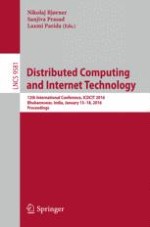2016 | Book
Distributed Computing and Internet Technology
12th International Conference, ICDCIT 2016, Bhubaneswar, India, January 15-18, 2016, Proceedings
Editors: Nikolaj Bjørner, Sanjiva Prasad, Laxmi Parida
Publisher: Springer International Publishing
Book Series : Lecture Notes in Computer Science
